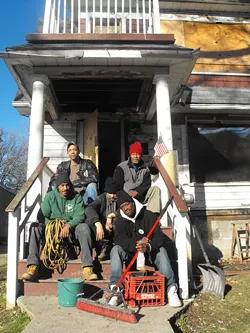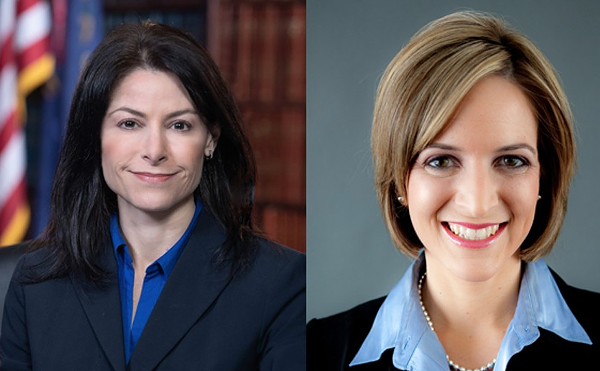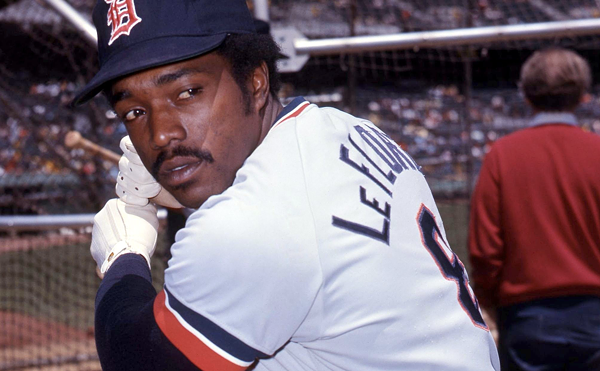
Audio By Carbonatix
[
{
"name": "GPT - Leaderboard - Inline - Content",
"component": "35519556",
"insertPoint": "5th",
"startingPoint": "3",
"requiredCountToDisplay": "3",
"maxInsertions": 100,
"adList": [
{
"adPreset": "LeaderboardInline"
}
]
}
]

In some ways, the Occupy Detroit movement, especially now that it has moved out of downtown's Grand Circus Park, is like a spider web, with strands shooting off in various directions but still connected, even if sometimes tenuously.
Some in the movement are focusing on the electoral process. Others see education — especially in terms of economics and political power structures — as the area of primary focus. For others, both here and in other cities, it is something they call Occupy the Hood.
In this case, the Hood is a cluster of vacant houses along Goldengate, a few blocks south of Seven Mile between Woodward and John R.
The idea is simple enough: Begin reclaiming neighborhoods one house at a time.
Which is why a small group of people are working on a cluster of four houses, trying to make them habitable.
In a way, this neighborhood — parts of which look as if it's been hit by bombs — seems a universe away from the gleaming towers of Wall Street. In fact, though, there is a direct connection between there and here.
Eric Sewell, 48, explains how it all ties together, sitting on a folding chair in a room that has no heat.
As the mortgage industry was deregulated, the doorway to fraud opened wide. Unscrupulous real estate agents and appraisers and mortgage brokers began "flipping houses," selling them back and forth, driving prices up far beyond their true values. Houses that started out selling for $30,000 doubled and tripled in price as they changed hands in sham deals; those mortgages were then bundled and sold to investors, who believed them to be a safe place to put their money.
Or, in other cases, naïve homeowners — often elderly people on fixed incomes — were convinced by brokers trained in the art of deception to refinance homes that had been previously paid off, getting an infusion of cash without knowing that interest rates would leap at some time past a point they could continue to afford.
These mortgages, too, were bundled and sold to investors who believed them to be secure. The scam worked as long as housing values continued to rise. But when the bubble burst, it all came tumbling down, leading to the economic crisis that began in 2008.
The banks and Wall Street firms received hundreds of billions of dollars in bailouts. Cities like Detroit, already being abandoned as the flight to the suburbs that began in the 1950s continued, were dealt a devastating blow.
"Bottom line consequence is that a lot of what you see here now is the result of Wall Street greed," says Sewell, a tall guy with an athletic build. "Houses that at one point sold for $100,000 dropped to $2,000, if that."
Now they sit vacant.
Sewell's life has been equally tumultuous. The son of a white mother and black father, his family moved to France following the '67 riots. They eventually returned in time for him to attend Cass Tech. He went on to get a teaching degree from Wayne State, with a specialty in foreign language instruction.
A felony drug conviction, he says, derailed any chance at a public school job.
When the Occupy Detroit encampment sprang up in October, he, like a number of others who gravitated there, was homeless. He did, however, have a job, working at a club as their "go-to guy," doing whatever needed to be done, from washing dishes to handing out fliers.
"I think the Occupy Movement is the movement I've been waiting for all my life," he says. "I went to Grand Circus Park, and I saw all these people who wanted to make a difference."
And he, in turn, was inspired.
Racism is a fact of life. There's no getting around it, he says. What makes being in the movement different, he explains, "is that it is something we can talk about and address.
"It is like a marriage. You have to keep the line of communication open. As long as you do that, you will stay together. And as far as this movement goes, it's like we all got married."
He looks around the house, and says, "This is like Ground Zero."
The goal, at least the first one, "is to get it to be Ground One."
Rebuild the community, room-by-room, house-by-house.
"You have to be a special kind of person to be squatting like this," he says, pointing out what's apparent. It's not easy. There was a wood-burning stove that they'd installed in one of the houses, but some young Occupier from Santa Cruz didn't heed the advice given him and stuffed it too full, causing it to overheat and setting the roof on fire.
But no one was hurt. Firefighters arrived within minutes, dousing the flames. The next day, they repaired the roof.
"You make a mistake. You learn from it and you move on," says Erik Shelley, a 45-year-old freelance audio engineer who's married and lives in Redford. Tall and cheerful, he seems to be the glue that helps hold together what the other Eric describes as the "get-shit-done crew."
It's a crew that includes Tony Hunter, 49. He's out of work, and walks with a noticeable limp from being shot in the leg.
It's a tough neighborhood.
Across the street, a mostly white group of college-aged kids is reclaiming another house, filling windowless frames with a mixture of clay-laden soil and straw surrounding empty wine bottles to let in light.
It is innovative, cost-free, and remarkably beautiful.
Across the street, the "get-shit-done crew" is focusing on getting heat in at least one room.
There are a lot of neighborhoods in Detroit where people squat. The difference here is that this is being done for a larger purpose, not just to exist. It is part of the movement, and the goal is to rebuild.
Other Occupiers are trying to figure out how to get titles to properties like these so they can be legally taken over. In the meantime, this Occupy the Hood movement is moving forward.
Sewell talks about the importance of getting heat as winter approaches. He and his peers in the Occupy movement figure that others in the neighborhood will flock in if they can provide warmth.
"For most people," Sewell says, "heat is a utility. But in this neighborhood, heat is a commodity. You know what I mean by that. A lot of people don't have it. And so they will come here to get it."
But they aren't looking to be a warming center.
"This is not a social service," Sewell says, a no-nonsense edge taking hold of his voice. "This is a movement. We're trying to build something here, even if it means we have to do it one room at a time."
But they can't do it alone. They need help. Help in the form of volunteer labor. Help in the form of building materials. Asked if he believes they will succeed, Tony Hunter, the guy with the gunshot leg, ponders the question for a moment, then replies, "That's hard to say. It could go either way. But it definitely won't work if people don't come together.
"Folks can start by coming down here to see what we are all about."





